Differences Between JD Edwards and Cloud ERP
-
Posted by Quest Customer Learning Team
- Last updated 5/26/23
- Share

Differences Between JD Edwards and Cloud ERP
In a March 2023 Quest webinar, Jennifer Turner, a Senior Director at Terillium, and David Green, a Principal Consultant at Terillium, shared the functional differences between JD Edwards and Cloud ERP as well insights to Oracle’s ERP direction with examples and demos. Both Jennifer and David have experience implementing JD Edwards and integrating Oracle Cloud ERP.
JD Edwards and Cloud ERP Comparisons
Many features of the JD Edwards and Oracle Cloud ERP are comparable, but the charts below highlight the key differences between JD Edwards and Cloud ERP for each module.
General Ledger
While many aspects of General Ledger are similar in both products, there are some notable differences in functionality.

JD Edwards has advanced cost accounting, which allows for advanced analytics. Meanwhile Oracle Cloud has pre-built analytics and dashboards, which are available to any user. Additionally, these out of the box analytics that you get with Oracle Cloud General Ledger are notable functionalities that differentiates Oracle Cloud. These allow people to be much more proactive than reactive. A common theme you’ll find is that users are now able to receive the data that is pushed to them without going looking for it. Features include:
- Smart View Excel Plug-in
- User friendly analytics with drill-back
- Reusable templates and ad-hoc general ledger reporting with interactive comparisons
- Pre-built out of the box analytics with simple configuration and quick time to value
- Actionable insights
- Proactive vs. Reactive push of data

Accounts Payable
Again, JD Edwards and Cloud ERP are comparable in many Accounts Payable functionalities. The key differences between JD Edwards and Cloud ERP in Accounts Payable are emphasized in the chart below.
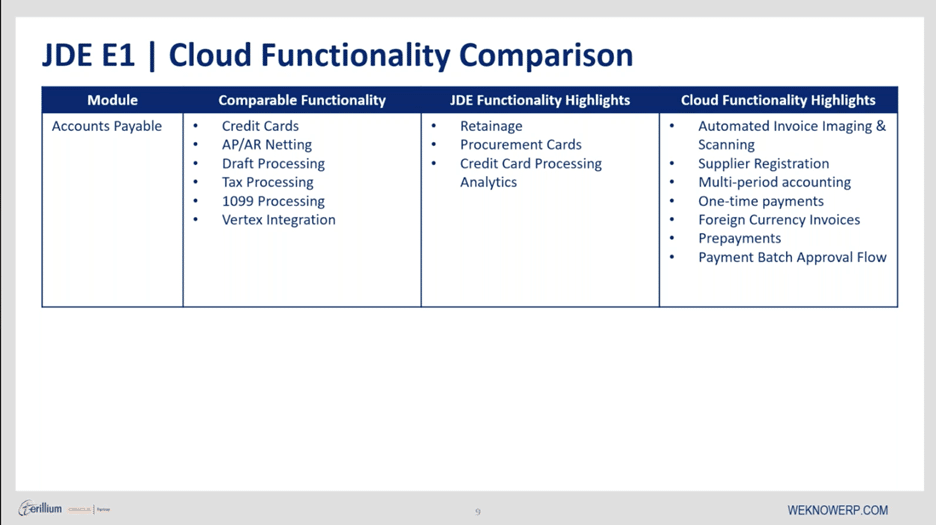
One functionality difference is that JD Edwards has retainage functionality that is not available within Oracle Cloud. Meanwhile, Cloud has automated invoice imaging and scanning, which allows you to be more efficient so that transactions are automatically created for you.
Fixed Assets and Expenses
JD Edwards and Oracle Cloud ERP are also comparable in Fixed Assets and Expenses. However, JD Edwards has a Real Estate Management integration, which is not available in Cloud. However, Oracle Cloud does include Lease Management & Compliance. Additionally, Cloud has the ability to use Automated Imaging through IDR (Intelligent Document Recognition). For example, IDR can automatically create an expense item by simply attaching a receipt to an email and sending it to a specified email address. These differences between JD Edwards and Oracle Cloud ERP are noted in the chart below:
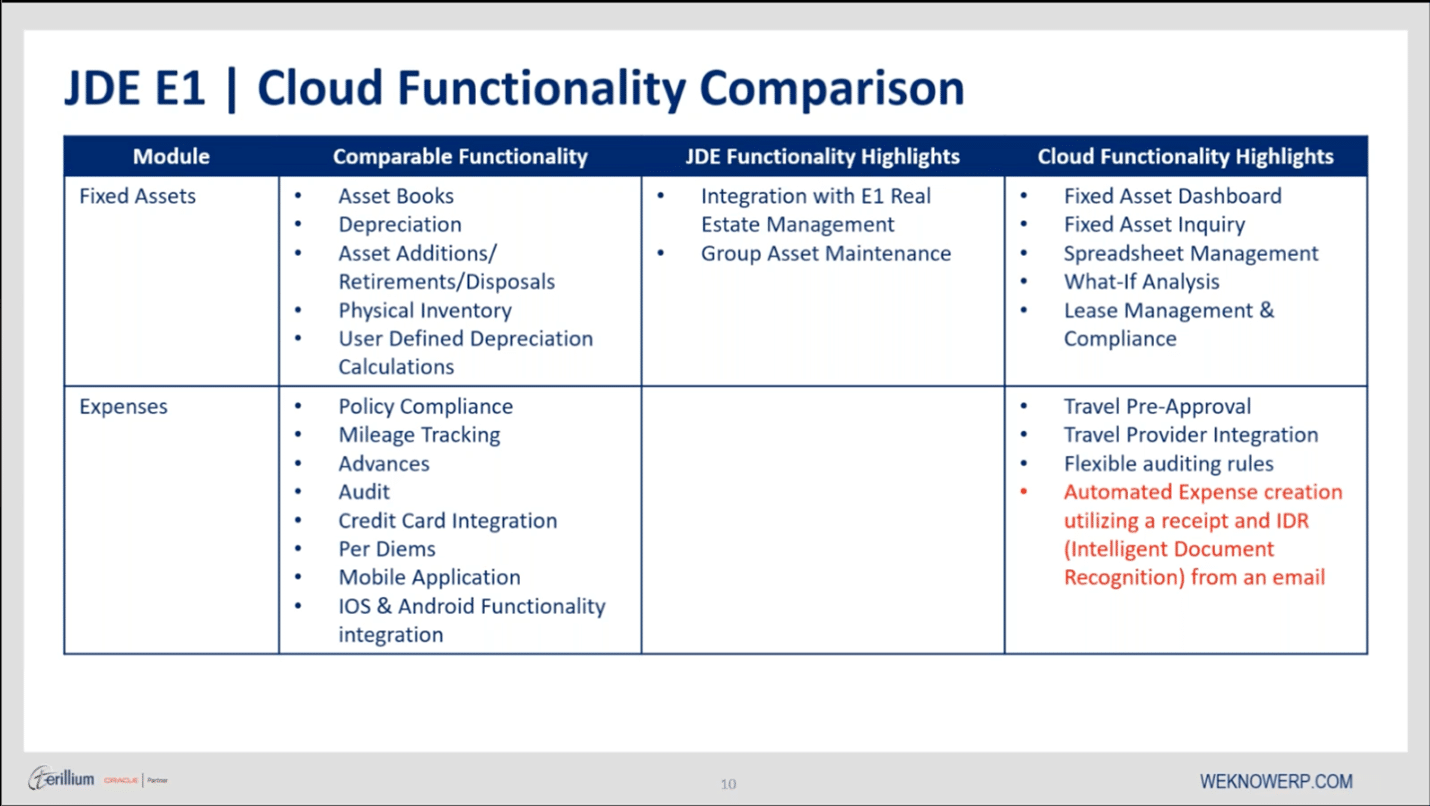
Accounts Receivable and Advanced Collections
In Accounts Receivable and Advanced Collections, there are still many comparable functionalities between JD Edwards and Cloud ERP, as seen in the chart below:

However, JD Edwards credit card processing is still a bit more mature than what is available in the Cloud. The Cloud product is coming along, but JD Edwards is superior at the moment.
Within Oracle Cloud ERP, Revenue Management and Subscription Billing are standout functionalities and key in the marketplace.
Taking a deeper look at Subscription Management and Revenue Management, the images below show how you might set up a subscription. Subscriptions can be based upon a standard dollar amount, usage, calculations, etc. There is a good amount of flexibility within the module. It integrates directly with Oracle Revenue Management Cloud Service, which allows you to be compliant with IFRS 15 and ASC 606. It will take revenue from any revenue stream into Revenue Management, where it will go through extensive calculations on what the recognition should be and what should be deferred.
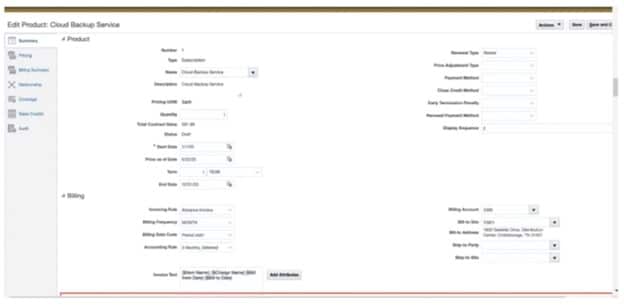

Cash Management, Localization/Globalizations, and Projects/Job Costing
Regarding Cash Management, like in most modules, both applications are comparable. However, the Smart View Integration function in Oracle Cloud is also notable here. Both Localizations and Globalizations are comparable in both products. However, Oracle continues to invest in research and development for additional Localizations with each release of Oracle Cloud. JD Edwards and Oracle Cloud both are able to do effective Cost Capitalization. However, there is a Project Costing and Project Execution module in Oracle Cloud as well as a Primavera P6 integration.

Purchasing/Self-Service Procurement
In Procurement, both JD Edwards and Cloud ERP handle the Procure to Pay lifecycle very well. However, there is robust management throughout the entire procure to pay process in the Cloud. The mobile punch-outs and catalogs are easy for users to do within the Cloud, with a feel that is similar to that of Amazon.

Sourcing
Both JD Edwards and Oracle Cloud ERP have Sourcing abilities like Response Structures and invites. On the Cloud, complex and strategic sourcing events can be supported.

Procurement Contracts and Inventory Management
Both products support Supplier Agreements. However, the differences between JD Edwards and Cloud ERP are evident here. Oracle has turned Cloud into full Enterprise Contracts Management system with a full-contracts buildout as detailed in the chart below. These contracts can be related across the entire organization.

Additionally, in Inventory Management, you can see that there is a lot of comparable functionality. However, within Oracle Cloud EPR, there are the additional out of the box analytics.
Below is an example of getting a signature on an enterprise contract looks like with Oracle Cloud:


Supplier Collaboration
While both products provide the basic Supplier Collaboration functionality. Collaboration with customers, vendors, or any other person outside of your four walls is made easier with the Cloud, highlighted in the chart below.

Order Management
When talking about the difference between JD Edwards and Cloud ERP, both systems can do full Fulfillment, Order Capture with multiple order types, Reservations, Allocations, and Up-Sell and Cross-Sell.

You can also do advanced pricing with both applications. JD Edwards offers advanced pricing with a robust pricing engine. Meanwhile, the Cloud’s functionality is similar, but it can be extended with rules and Groovy Scripts.
Manufacturing
While both products are able to do Mixed-Mode Manufacturing. They can both also handle Discrete and Process manufacturing.

However, Cloud ERP functionality brings in much more IoT, including blockchain with trace-n-track.
A key feature in the Cloud is the full cycle planning. You can do demand and supply planning, as well as inventory planning. As you move beyond the pure supply chain, there is additional integration between the modules that exist today.
Integrated Business Planning and Execution (IBPX) are especially significant. By connecting the two processes, your enterprise can receive the following benefits:
- Single source of truth for financial planning with sales and operation planning
- Consolidates all planning into a unified connected planning
- Seamlessly integrates planning with execution and establishes a solid foundation for business transformation
- Integrates planning business processes across financial and operational
Future Direction for Oracle Cloud
What is different about the Cloud? With traditional solutions, including on-prem, the solution is located on your servers behind your firewall. You purchase an up-front, perpetual license. You own and maintain the hardware, providing technical support, patching, and updates. The software is delivered or shipped to you.
With the Cloud, the solution is located somewhere else, accessed via the internet. You pay a subscription fee. The vendor owns and maintains hardware (IaaS) and provides support, patching, and updates at regular intervals.
Modern software today is typically SaaS. It is subscription-based.
Today’s users entering the marketplace don’t remember life without a cell phone. They don’t have any idea what the white or yellow pages are—they’re accustomed to Google and immediate access to information. Users will speak into their devices all day long, but can be slow to engage with a live person over the phone. They want to do things on their own, as self-service, and only know a punch-card as a means to a free sandwich or cup of frozen yogurt.
Below is an example of a typical Friday night for several families across the U.S.:
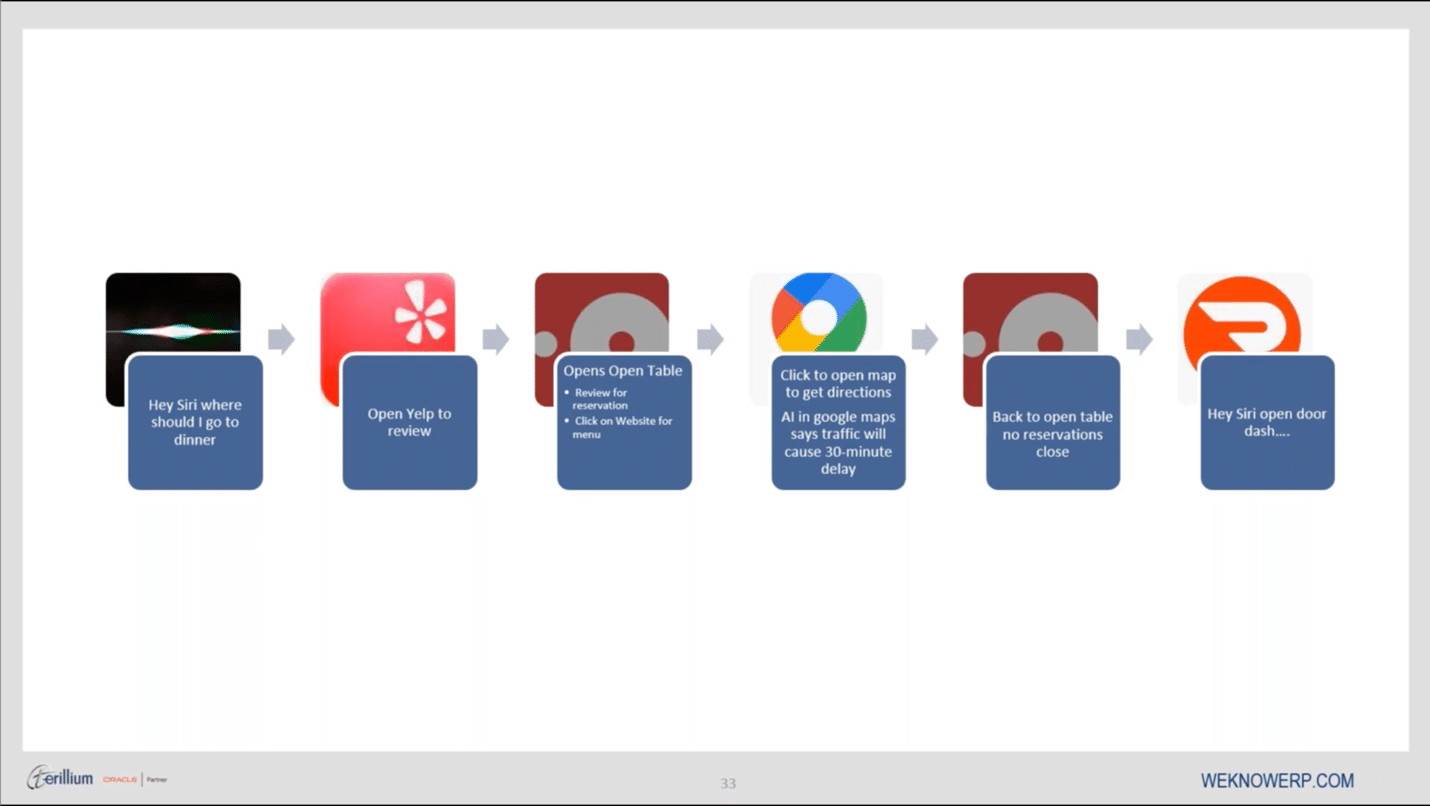
This outside-of-work example represents the following:
- Mobile enabled
- Voice activated
- Self service
- Artificial intelligence
- Real-time analytics
- Integrated services
- Social
- Visual
When you look at all of those things and then check where Oracle is headed directionally with their Cloud products, it’s easy to see the future of Oracle:
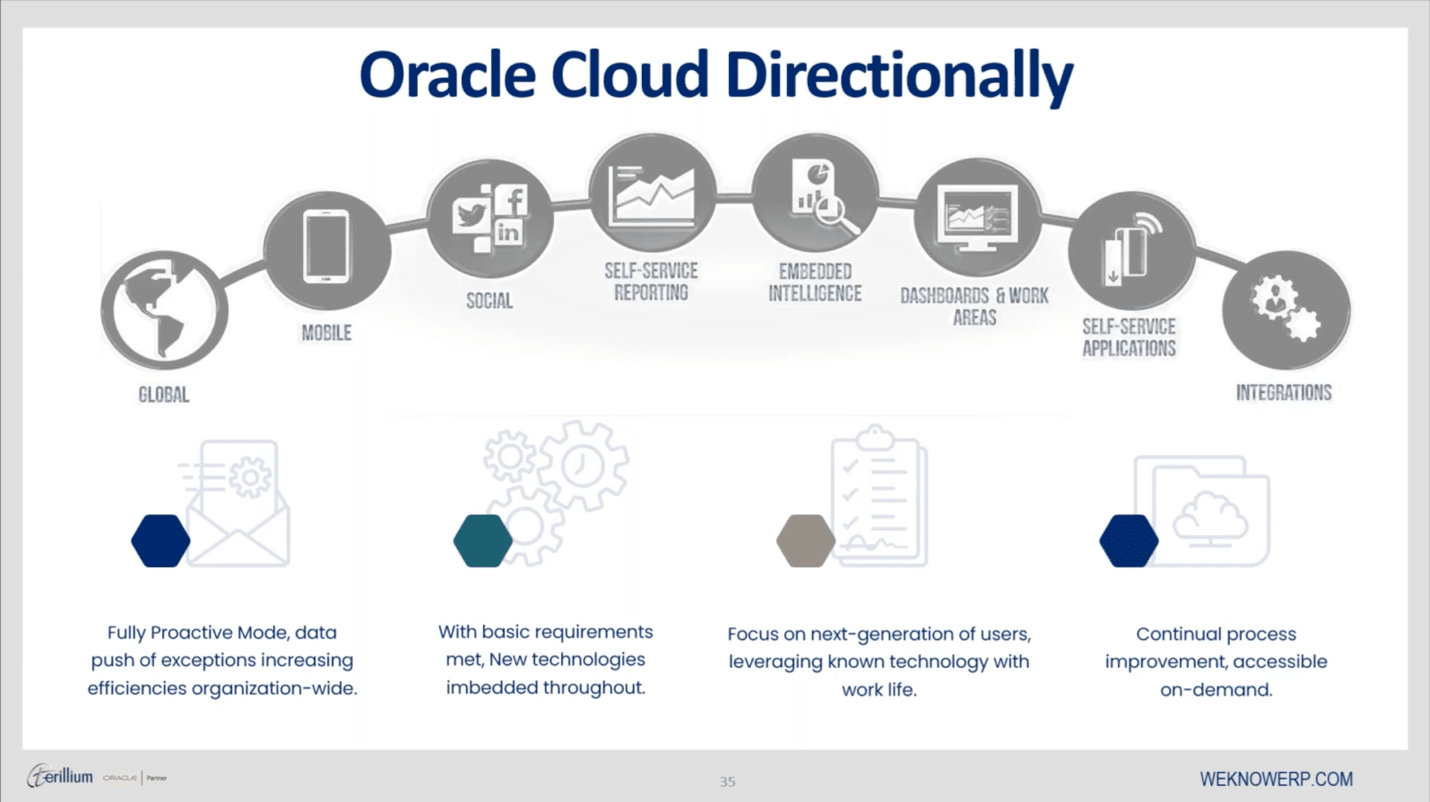
Oracle is putting users into a position to be proactive for their organizations. They’re expanding into new technologies, embedding them throughout applications. The focus is on next-generation users, who have only known this type of technology outside of work and expect it at work.
This leads to a continuous improvement methodology. Oracle sends out quarterly releases, arriving turned off so that you can uptake them as it works best for your organization.
Oracle Cloud Examples
Oracle Journeys
An Oracle Journey is a guided task list enabling the user to manage required tasks efficiently and effectively in a single application. Journeys cover a range of categories such as pre-boarding, onboard, and off-boarding to track or manage tasks.
Below shows an example of a user, Paul, who is looking for a promotion or increased responsibilities to climb the ladder at his organization. From the My Journeys tab, he is able to click on the Grow Your Career tile.

In Grow Your Career, Paul can view the tasks he has already completed and those he has not.

Paul clicks “Welcome to your Journey” to work on the only required task he hasn’t completed. Then, Paul is taken to the embedded video. After watching it, the task will show that it was completed.

The opportunities for using Journeys are endless. The journeys show the connectedness, integration, and self-service applied by Oracle.
Digital Assistants and Chatbots
The Oracle Digital Assistant delivers a complete AI platform to create conversational experiences for business applications through text, chat, and voice interfaces.
Below are three examples of conversational chatbots:

Artificial Intelligence and Machine Learning
Artificial Intelligence and Machine Learning are exciting examples of Oracle Cloud technology. Within the Cloud product in Accounts Payable, Oracle has embedded IDR (Intelligent Document Recognition). When an invoice comes in from a vendor or supplier, you can capture it and it will be stored for access:

However, not all invoices look the same, and the technology won’t necessarily read it correctly the first time. That’s where Artificial Intelligence and Machine Learning work together to allow you to teach the system how to read the invoices, as in the image below:

Key Takeaway – Differences Between JD Edwards and Cloud ERP
Oracle is catering to the new users entering the workforce. With Oracle technology, it is possible to have the same type of digital interactions at work as users do at home.
If you are a current JD Edwards customer, there are a few paths forward into the future of ERP:
You can:
- Modernize with Oracle Cloud Infrastructure & move your JD Edwards onto a digital platform. If you go this route, you’ll see 40–50% in OPEX savings and you’ll have a “True” zero data center.
- Complement JD Edwards with Oracle Fusion Cloud components. You can adopt by business process and leverage the enabling technologies.
- Migrate to Oracle Fusion Cloud from JD Edwards with Full Oracle Fusion ERP. This includes an application and platform migration, eliminating your on-premises solution.
To learn more, you can watch the full webinar here: Oracle Cloud ERP – Next Generation Business Interaction Webinar.
